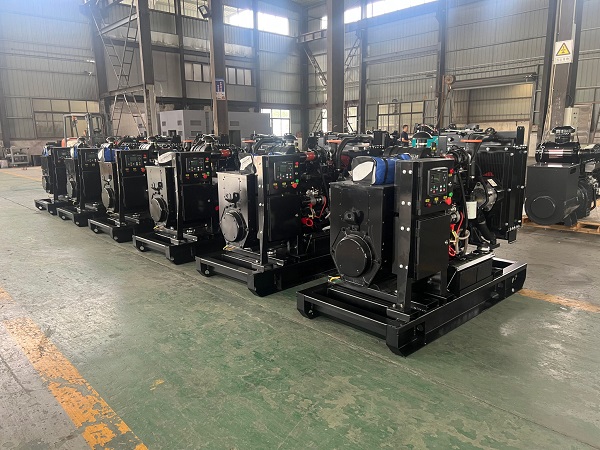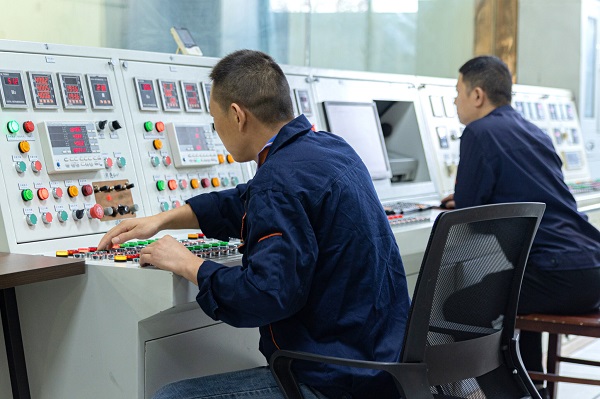Comprehensive Guide to Initial Start-Up of Industrial Generators
As a global leader in industrial power solutions, Shengrong Power is committed to providing safe, efficient, and intelligent power equipment. This article details the standardized process for the initial start-up of industrial generators, covering different operations for diesel/gas units, in-depth use of intelligent control systems, and troubleshooting and emergency response plans. Based on the ISO 8528-5 international standard and Shengrong Power’s proprietary technology, this guide helps users build a full-life-cycle power support system.

1. Pre-Start System-Level Inspections
1.1 Mechanical System Verification
First, check the foundation. Use a laser alignment tool to measure the unit’s levelness, ensuring the tolerance is ≤ 0.05mm/m. Tighten the foundation bolts to 110% of the designed torque to prevent vibration during operation.
Next, inspect the drivetrain. Manually rotate the crankshaft for at least 3 full turns to check the flywheel ring gear meshing gap (0.25–0.4mm is ideal). Replace any cracked or aged coupling dampers to avoid excessive vibration.
For the fuel system, let new diesel sit for 48 hours to allow impurities to settle. For gas units, ensure the methane purity is ≥ 95% and hydrogen sulfide content is < 20mg/m³ to prevent engine corrosion.
1.2 Electrical System Testing
Test the insulation resistance using a 500V megohmmeter. The stator winding should show ≥20MΩ (cold state), and the excitation winding ≥1MΩ. A lower reading indicates potential moisture or damage, requiring drying or repair.
Check the grounding system: the ground resistance must be ≤4Ω. Connect all metal components with an equipotential bonding system to keep the potential difference <0.5V, which protects against electrical faults and static discharge.
Calibrate the control circuit’s analog and digital signals. Ensure analog input/output accuracy is within ±0.5% and digital signal response time is <50ms to maintain reliable control.
1.3 Intelligent System Initialization
Configure the controller via Shengrong Power’s iGenius cloud platform. Set key parameters such as:
- Voltage regulation range: ±5% (customizable to ±2.5% for precision loads)
- Frequency regulation accuracy: ±0.5% (steady state) / ±1.5% (dynamic state)
- Overload protection threshold: 110% of rated power (anti-time delay characteristic)
Install the iGenius Edge gateway to enable real-time data upload to the cloud. This allows remote monitoring via both mobile apps and PC platforms, ensuring you can track the unit’s status anytime, anywhere.
2. Diesel Generator Start-Up Procedures
2.1 Cold Start Process
First, pre-lubricate the engine. Activate the electric pre-lubrication pump to build main oil gallery pressure ≥0.2MPa for at least 30 seconds. This ensures all moving parts are properly lubricated before starting.
Next, purge the combustion chamber. Open the intake valve and crank the engine 3–5 times with the starter motor to remove residual gases, which improves ignition reliability.
Start the engine by setting the speed control lever to 1/3 opening. Press the start button, but do not hold it for more than 15 seconds. Wait at least 2 minutes between attempts to avoid battery drainage.
After starting, warm up the engine at 1000rpm. Wait until the water temperature reaches 60°C and oil temperature 55°C before increasing the speed to the rated value, which prevents thermal stress on engine components.
2.2 Load Application and Synchronization
Run the generator under no load for 15 minutes to check vibration (ISO 10816-3 standard, grade ≤G6.3). Excessive vibration indicates misalignment or imbalance, requiring immediate inspection.
Add load in stages: 25%, 50%, 75%, and finally 80% of rated load, with 5-minute intervals between stages. This gradual loading allows the engine to adjust thermally and mechanically, reducing stress.
When synchronizing to the grid, use an automatic synchronizer to match voltage (difference ≤5%), frequency (difference ≤0.5Hz), and phase angle (difference ≤15°) to ensure a smooth connection without power surges.
3. Gas Generator Start-Up Special Techniques
3.1 Gas System Preparation
Regulate the gas pressure to 30–50kPa (model-specific). Install a pressure sensor to monitor stability, as fluctuations can affect combustion efficiency.
Purge the gas pipeline three times (30 seconds each) to remove air and ensure the gas concentration is <1% LEL (lower explosive limit). This prevents explosive mixtures in the combustion chamber.
Inspect the spark plugs, setting the gap to 0.6–0.8mm. Test the ignition coil secondary voltage (≥15kV) to ensure a strong spark for reliable ignition.
3.2 Intelligent Combustion Control
Use the iGenius controller to monitor O₂ and CO levels in real time. Adjust the air-fuel ratio to keep the excess air coefficient (λ) between 1.05 and 1.15, optimizing both efficiency and emissions.
Install a knock sensor to detect abnormal combustion. If knocking occurs, the system will automatically retard the ignition timing and reduce load to protect the engine from damage.
4. In-Depth Use of Intelligent Control Systems
4.1 iGenius Cloud Platform Functions
The platform uses AI to analyze vibration spectra and oil debris, predicting potential faults with >92% accuracy. This proactive approach helps schedule maintenance before failures occur.
It also optimizes energy consumption by automatically adjusting the number of operating units based on load demand, improving parallel operation efficiency by 15%.
For emergencies, the system sends SMS/email alerts within 30 seconds of critical parameter deviations, ensuring quick response to issues.
4.2 IoT Architecture
The iGenius Edge gateway processes local data with a response time <100ms, enabling fast control actions. Data transmission uses AES-256 encryption to protect against cyber threats.
It supports Modbus TCP/OPC UA protocols, allowing seamless integration with SCADA systems for centralized monitoring and control in industrial environments.
5. Troubleshooting and Emergency Handling
5.1 Common Start-Up Failures
- No Starter Response: Check the battery voltage (must be ≥12.5V). If low, charge or replace the battery.
- Engine Cranks but Won’t Start: Release the bleed screw on the fuel pump to remove air from the fuel line, which is a common cause of ignition failure.
- Unstable Speed: Re-tune the governor’s PID parameters. Incorrect settings can lead to speed fluctuations, so consult the manual for proper calibration.
5.2 In-Run Abnormalities
- Overvoltage (>110% rated): The system will trip the output breaker automatically. Check the voltage regulator and wiring before restarting.
- Overspeed (>115% rated): Emergency shutdown triggers within 200ms. Inspect the governor and speed sensor for faults, as this is a critical safety function.
- Fire Emergency: The FM200 fire suppression system links with the shutdown signal. Regularly test the system and keep fire extinguishers accessible for immediate action.
6. Maintenance and Care Plan
6.1 Preventive Maintenance
- Daily Checks: Record oil/water temperature, pressure, and leaks. Early detection of small issues prevents major breakdowns.
- Monthly Maintenance: Replace air filters and clean radiator fins to maintain cooling efficiency and air flow.
- Annual Overhaul: Inspect piston ring wear (limit 0.5mm) and test insulation resistance to ensure long-term reliability.
6.2 Smart Maintenance
- Oil Analysis: Conduct spectroscopy quarterly, with an iron content threshold ≤50ppm. High metal levels indicate wear in moving parts.
- Vibration Monitoring: Use a portable vibrometer; high-frequency vibrations (>5g) signal potential bearing or gear issues, requiring immediate attention.
- Life Prediction: The iGenius platform forecasts component lifespan, sending alerts 6 months in advance of expected failure, enabling timely replacements.
7. Safety Operation Guidelines
7.1 Personnel Protection
Always wear insulated shoes, a safety helmet, and safety goggles in the engine room. Have a second person monitor all live operations to ensure safety.
7.2 Environmental Safety
Install H₂S/CH₄ detectors that trigger ventilation when gas levels rise. The fuel storage area must have a containment bund (capacity ≥110% of the largest tank) to prevent spills and environmental hazards.
7.3 Emergency Drills
Conduct quarterly power failure simulations to test the backup power switchover time (<10 seconds is ideal). Maintain a detailed emergency manual with clear flowcharts for common issues, ensuring all operators are familiar with procedures.
8. Shengrong Power Service System
We offer:
1.24/7 Cloud Support: The iGenius platform provides real-time technical assistance.
2.Rapid Response: 400 hotline answers within 30 minutes, with on-site service in 2 hours for urgent issues.
3.Genuine Parts: A stock of over 100,000 spare parts ensures 98% of orders ship within 24 hours.
4.Custom Training: On-site operation and maintenance courses to ensure your team can manage the equipment effectively.

The initial start-up of an industrial generator is a critical step for safe and reliable power supply. Shengrong Power’s integrated approach combines mechanical precision, electrical safety, and smart control to ensure a smooth start-up. By following this guide, users can minimize risks, optimize performance, and lay the foundation for long-term efficient operation. Contact our company to get customized generator at the competitive price: marson@generatorsr.com.
